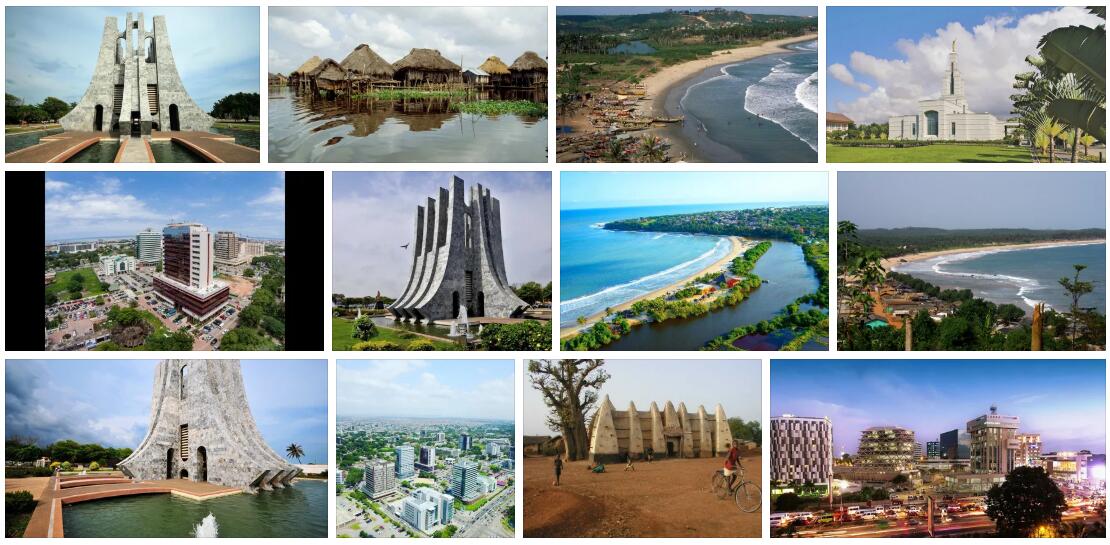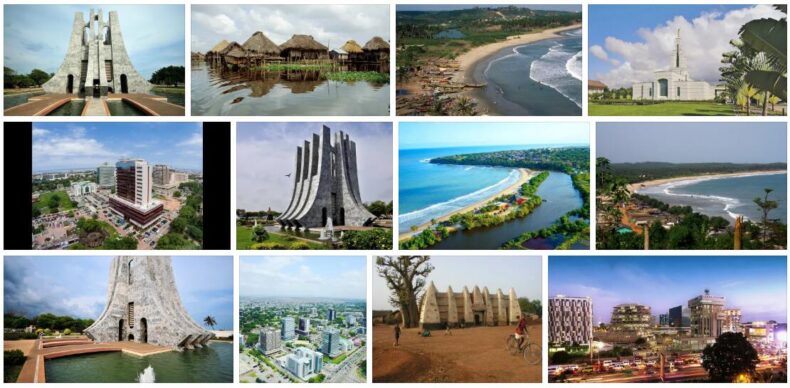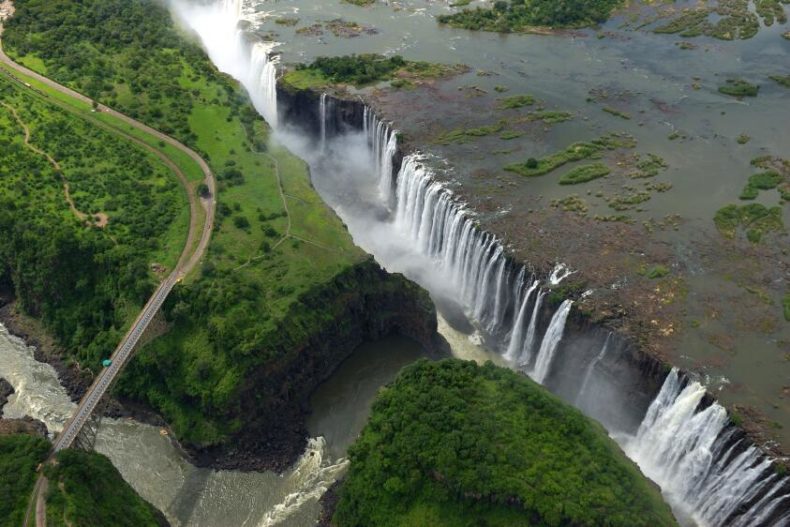According to ABBREVIATIONFINDER, Ghana is a state in West Africa. It is bordered by the Gulf of Guinea to the south, Burkina Faso to the north, the Ivory Coast to the west and Togo to the east.
The state includes the former British colony of Gold Coast and part of the former German colony of Togo.
A narrow coastal plain joins the coast to the north. Inland follows a highland cut up by valleys. To the north it goes over to the basin of the middle Volta. The 1600 km long Volta is the main river in the country. The Volta Reservoir is the largest reservoir in the world. The south of Ghana has a hot, humid tropical climate with two rainy seasons. Tropical rainforests and wet savannas dominate. In the north, with only one rainy season, the dry savannah predominates as a type of vegetation.
With 52%, the Akan are the largest tribal group in Ghana. 36% of the population live in large cities with more than 100,000 residents. Over 60% are Christians.
The basis of the economy is agriculture, which is mainly operated for self-sufficiency. Agriculture also generates more than half of the export revenues, mainly through the cultivation of cocoa. Ghana is rich in natural resources. Gold, bauxite and diamonds are mined. Gold has always been the most important export item.
The British Crown Colony, the Gold Coast, gained independence in 1957 and is now the Republic of Ghana.
Ghana is about the size of Great Britain. From the Gulf of Guinea in the south, Ghana stretches about 630 km to the north (Fig. 1).
The capital is Accra.
Natural space
In the south, Ghana has a 535 km long coast on the Gulf of Guinea. It is poorly structured and extends from the mouth of the Volta in the east to the border in the west.
It is joined to the north by a 30 to 60 km wide coastal plain. Inland follows a highland cut up by numerous valleys, which in the Ashanti threshold reaches a height of 788 m.
The highlands merge to the north to the basin of the middle Volta. The Volta Basin runs roughly in a north-south direction at a height of 150 to 300 m. A large part of this basin is occupied by the Volta reservoir.
Waters
The most important river in the country is the 1600 km long Volta. It is dammed up by the Akosombodamm in the lower reaches of the Voltasee, which with 8482 km² is one of the largest reservoirs on earth.
Climate and vegetation
The south of the country has a hot, humid tropical climate with two rainy seasons. They occur in the months of April to June and October / November. In the extreme south-west of the country the highest amount of precipitation falls with up to 3000 mm per year, in the rest of the south falls up to 2000 mm per year. Coastal savannas, tropical rainforests and wet forests characterize this landscape.
The north of the country is shaped by influences from the Sahara. There is only one rainy season. In winter, the dry harmattan blows from the Sahara. The dry savannah predominates here.
In many areas the flora has been fundamentally changed by humans. In the heavily populated regions of the coast and the south, the original forest has been replaced by a cultural landscape. It is characterized by agriculture and palm plantations.
Important data about the country
| Surface: | 238 533 km² |
| Residents: | 21.4 million |
| Population density: | 90 residents / km² |
| Growth of population: | 2.2% / year |
| Life expectancy: | 54 years |
| State capital: | Accra |
| Form of government: | Presidential Republic |
| Languages: | English (official language), Kwa languages, Gur languages, Ful, Nzima |
| Religions: | Christians 62%, followers of natural religions 23%, Muslims 15% |
| Climate: | Tropical, hot and humid climate with two rainy seasons in the south and one rainy season in the north |
| Land use: | Arable land 12%, pasture land 15%, forest 37.2% |
| Economic sectors: (share of employees) |
Agriculture 36%, industry 25%, services 39% |
| Export goods: | Cocoa, gold, aluminum, diamonds, manganese |
| Gross domestic product: | US $ 7,624 million (2003) |
| Gross National Product: | US $ 320 / residents (2003) |
Economy
Ghana is one of the economically better off countries in West Africa. There are mineral resources in the country and the conditions for agriculture are good. Agriculture forms the basis of the economy. Together with forestry and fisheries, it generates 50% of GDP and 70% of export earnings. The self-sufficient economy still dominates with the cultivation of corn, millet, cassava, yams, sugar cane, rice, peanuts, vegetables and bananas (Fig. 3). The agricultural structure of Ghana’s wet savannahs is characterized by individual farms or small village complexes. However, livestock farming is not enough for the required amounts of meat. More than two thirds have to be imported. Cocoa
is mainly used for export cultivated. It is produced in the Ashanti Mountains by small and medium-sized family businesses.
Ghana is rich in natural resources. Gold, diamonds, manganese and bauxite are mined. Gold is the country’s main export item. Industry employs 25% of all workers. The most important areas are wood processing and the textile and food industry. The electricity generated by the hydropower of the Volta reservoir is used industrially to produce aluminum. The surplus electricity generated is exported to neighboring countries.
Trading partners are Germany, Great Britain, the USA and the Netherlands.
The north of the country is poorly developed, and the transport network is only well developed in the south and south-east. Important ports are Sekondi-Takoradi and Tema, Accra has an international airport.
More than a quarter of all employed people work in the service sector. In addition to trade and transport, tourism plays a major role.
Since the mineral resources are mainly extracted in the south of the country, differences to the less developed north have emerged.
History
The area of what is now Ghana has been a magnet for African and European powers for centuries because of its gold wealth. It is to this fact that the area owes its former name to the Gold Coast. The first Europeans in Ghana were French who immigrated towards the end of the 14th century. Portuguese, British, Dutch, Swedes and Germans followed. They established branches and traded with the locals. The most important commodity was initially gold, later the slave trade continued until the beginning of the 19th century.
The British finally established a protectorate in the coastal area from 1844. In 1874 the southern part of Ghana became the British crown colony of the Gold Coast.
In 1922 part of the former German colony of Togo was incorporated. Efforts for independence led to the founding of the United Gold Coast Convention in 1947. Great Britain granted Ghana independence on March 6, 1957.
Ghana is a member of the UN. Dictatorships shaped its history, but a process of democratization began in the 1990’s. Ghana has been a presidential republic with a multi-party system since 1993.





